For my job at Oxford University Museums and Gardens, now part of GLAM, I attended the Axiell User Group Conference 2018 in Glasgow; we have two museums (MHS and MNH) that use the EMu collections management system,
I took the opportunity to spend a few extra days revisiting the city where I had been a postgrad between 1990 and 1992.

I arrived back in Glasgow on Sunday evening. At Glasgow Central station I bought a weekly Zonecard before proceeding on my way, anticipating quite a lot of travel around the city, reasoning that it should be more convenient than repeatedly buying tickets and I might save some money. Then I towed my luggage along St Vincent Street and Arygll Street to reach the Sandyford Hotel in Sauchiehall Street, where I had booked 5 nights’ accommodation.
A few minutes later under greyish skies, but dry at least, I headed for the waterfront, which was easy to reach from the hotel, using the SECC tunnel walkway

There were many passersby wearing conference lanyards with a great diversity of ethnicity, so I stopped one of them to ask. He explained that they were attending a congress of the World Federation of H[a]emophilia. It seemed a very laudable gathering, but seeing the multitude I soon guessed that was probably why accommodation prices seemed elevated. Soon I emerged by the river and proceeded to cross towards the Prince’s Dock, where once mighty ships would berth, supported by an array of cranes, warehouses and railway yards.
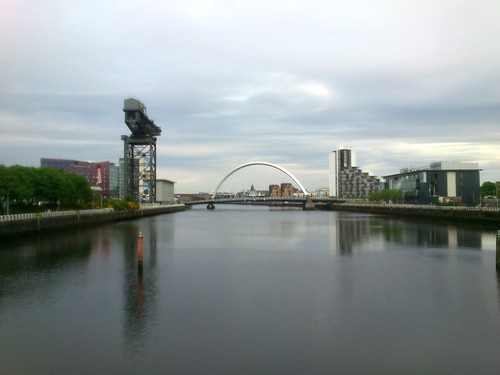
Now this has faded away, with much of the waterway reclaimed (the BBC Scotland occupies some of this area). The area has been redeveloped, but some vestiges of the old practices remain, including the Clyde Puffer.
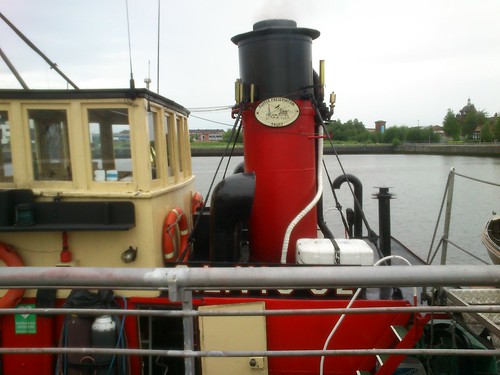
The next day, fuelled by a substantial cooked breakfast, I set out to explore at length, starting with Kelvingrove Park and then up to Gilmorehill, the location of the imposing Gilbert Scott Buildings, which form the central areas of the University of Glasgow.

A lady doing the polishing at the entrance to the Hunterian Museum explained that it was now quiet as the exams were over and the graduation ceremonies were yet to begin.
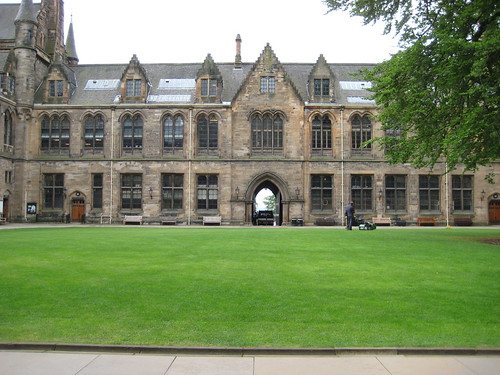
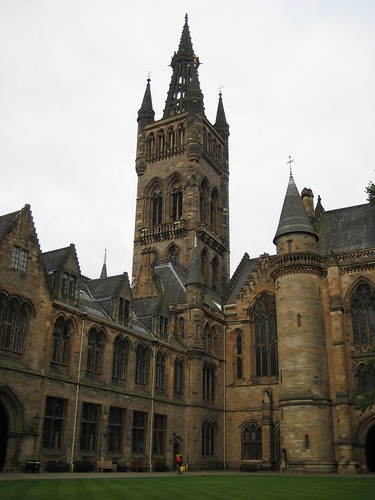
Around the corner, in Professors’ Square, was a distinctive sculpture in the form of an urn made of slate. It was produced by Andy Goldsworthy, a donation from a former Principal and his wife, Sir Graeme and Lady Davis:
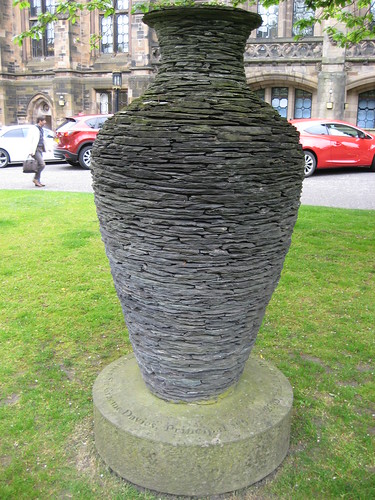
I then headed downhill to Church Street, but whereas the view used to be of the Western Infirmary, now I saw this:
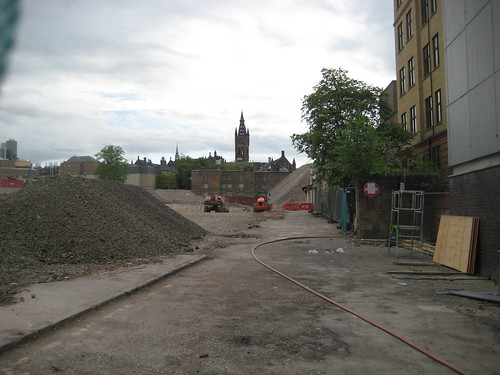
(sunyata!)
It’s a huge development site for the University (similar to the Radcliffe Observatory Quarter redevelopment in Oxford). Some ragged remnants still remain adjacent to the street:
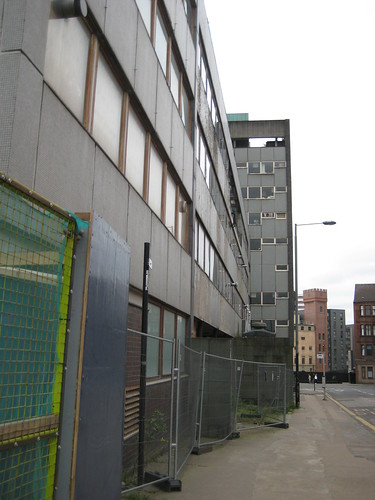
I returned to the main campus via Byers Road and then continued down University Avenue to University Gardens, where I used to receive instruction at the Maths Department at no. 8 and study at no. 11. Now it looked like this:
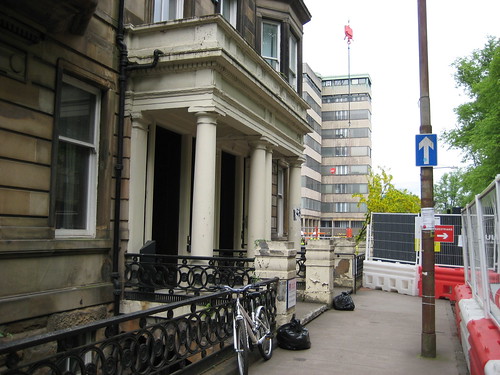
(sunyata!!)
At least they hadn’t knocked down the villa, a listed building from the 1880s, where I used to share a sparsely furnished office with other Maths postgrads at George Service House (number 11).
Next door, no. 13, was Hetherington House, home of the Hetherington Research Club, the scene of a student protest in 2011 “against cuts to higher education within Glasgow University and nationwide” (the Hetherington Research Club was closed in 2010). It got widely reported, including BBC coverage and a Wikipedia article.
Seeing that the Maths Department building, a block constructed in the late ‘60s in the Brutalist style, had been demolished I quizzed a security person (I assume) who was standing nearby. He said it was knocked down at the beginning of the year and the completion of the new construction was planned for completiion in 2 years’ time. I expect few would mourn the loss of the old structure.
The flat I shared in Church Street was appropriately described by my flatmate as "a hovel”; cheap, but not so cheerful. So after a few months I moved again and finally found a generally comfortable and affordable place to live, still close to the Maths Department, in Hillhead Street. So on my return I carried on, using a shortcut that I still remembered by Queen Margaret’s Union, to get onto Hillhead Street. And memories started to return…
Miss Macaulay, the landlady, was retired. She had previously run a rest home there, which was apparently particularly popular with Americans. As part of my induction she pointed to the Macaulay clan’s crest with its motto, ‘Dulce periculum est’, which she obligingly translated — “Danger is sweet!”. However, whilst she was proud of her heritage, her tone was not menacing and I was offered two rooms at a generous rate.
I don’t recall having taken any photos, but it’s not so hard to find glimpses of the interior. A few months after I had moved a production company came to do some filming for The Bogieman, a BBC Scotland Comedy Drama from 1992 starring Robbie Coltraine, Midge Ure et al. Here we see the detective approaching the home
Most of the flat was need for the filming, i.e., the entrance hallway, the two front rooms and the kitchen at the back (where they kept all the turkeys). Apparently when it came to finding the right location they reviewed 8 properties and this one won hands down; I don’t think they needed to use so many props for beyond the red door at the entrance was a plentiful supply of tartan, chandeliers, stags heads and especially brass, frequently augmented at weekends by new acquisitions from The Barras.
The BBC wrote to us individually advising what was going to happen. They very kindly allowed me to come and go as I pleased during the filming and I could stay there overnight as my rooms were not used (this also helped them in that I could watch over their equipment). On one occasion as I was making my way through the hallway I bumped into Robbie Coltraine coming out of the front room. Seeing me he immediately remarked in an affected voice, “Don’t go into show business!” and then carried on his way.
Now revisiting, I could barely recognise the flat — gone were the tartan curtains, the front door had been repainted; there was little sign of the distinctive colour from the past. I tried to strike a conversation with a resident outside, but she didn’t want to know (and looked at me with suspicion). So it was soon time to move on, down the hill, past The Mackintosh House
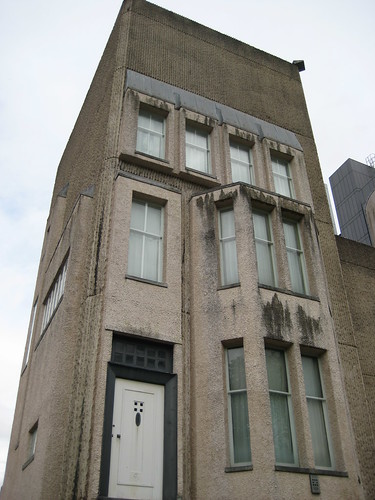
As it was Monday, I knew it would be closed, so next stop was the Kelvingrove Art Gallery and Museum,

It’s a fabulous museum, with a rich mixture of displays, some quite unexpected, particularly the multimedia object cinema, which I found quite immersive. However, I spent most of my time at ‘Mackintosh and the Glasgow Style Gallery’, a permanent display of work by members of the Glasgow School, particularly the Group of Four. Actually, there is also a special exhibition to celebrate 150 years of the birth of the leading light: Charles Rennie Mackintosh: Making the Glasgow Style. My only disappointment was not being able to see Dali’s Christ of St John on the Cross, which is currently on loan.
After coffee in the Centre Hall, I wandered along Argyll Street, past Kelvin Hall, where I remember watching international athletics. Its redevelopment is bringing together disparate Hunterian collections of the University. Its website includes a beta service with integrated online access to search the collections.
I had planned to explore Pollok Country Park on the south side, so it was on to the Underground, where the turnstile rejected my ticket first time I tried it and then again and again. The staff in the ticket office was watching on and gestured to hand over my card. He studied it and with furrowed brow concluded it was meant for buses. Not to worry as he could fix the problem if I waited 10 minutes. So I did and I continued on my way and emerged safely at St Enoch’s. But when I came to the platform where I was to catch the train for Barrhead, the turnstiles there rejected it also. “It’s the magnet”, explained the rail staff cheerily as he let me through. “Och well…”
Disembarking at Pollokshaws station, I headed for Pollok Country Park, passing by Pollokshaws Railway Viaduct, which spans White Cart Water. Built in 1847 and subject to a lot of rail traffic, it must need quite a lot of maintenance.

This scene somehow felt like a metaphor for working in an IT team.
A few yards along Pollok Avenue one finds Shawmuir Lodge, built in 1891, as the stone relief indicates (I guess):
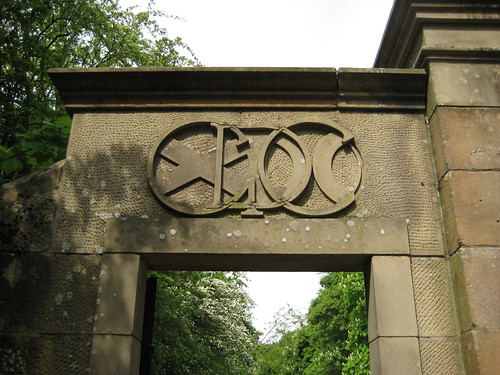
The grounds are part of an estate that belonged for many centuries to the Maxwell family until it was handed over to the Glasgow Corporation with the condition that it remained a public park. The stately home is Pollok House, maintained by the National Trust of Scotland. It’s currently featuring a photography exhibition, Harry Benson: from Glasgow to America, which I found really impressive — he vividly captures many aspects of life with a perfect sense of timing. And lunch was very good too.
The park was delightful with many blooms and I felt no need to investigate the Burrell Collection, though it’s actually ‘temporarily closed’ for refurbishment (estimated until 2020).

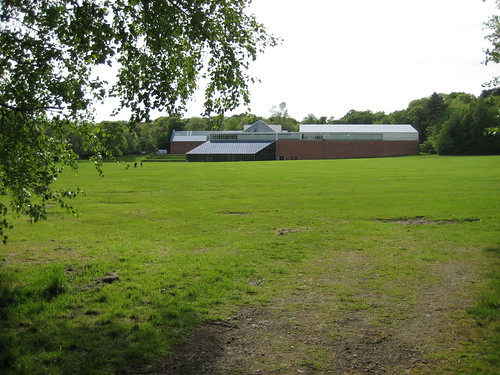
I returned to the hotel greatly contented with what I had seen.
The following day I explored towards the east, aiming for St Mungo’s, Glasgow’s cathedral. I took a slight detour to see what was happening with the refurbishment of the Glasgow School of Art following the fire of 2014.
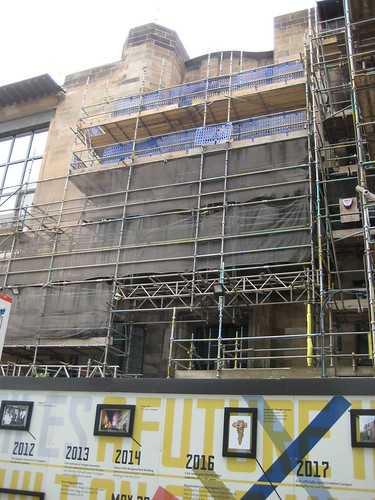
According to the information boards it will reopen in 2019 "as a base for all first year students from across all disciplines: architecture, design, fine art, innovation, simulation and visualisation". Using my map from 1990, I carried on, but lost my way when I hit Buchanan Galleries, a large shopping mall, but eventually I reached my destination and quickly made my way to the shrine of St Mungo. Similar to what happened in Oxford, the shrine gained special attention during the medieval period (in Oxford in the 12th Century, the relics of the patron saint, St Frideswide, were transferred to a special new shrine, and a miracle collection was authored by Prior Philip, detailing miraculous healings, on which I wrote an essay. This was formerly the Roman Catholic mother church of the Archdiocese of Glasgow, but following the Scottish reformation it has been under the Church of Scotland.
I gazed at leisure from the cafe in the nearby Mungo Museum of Religious Art and Life.

I found the museum itself unassuming and quite a lot larger than expected; it seems to unfold, floor by floor. As it doesn’t overwhelm, it lends itself to measured absorption; one can linger on the displays. Its exhibitions are planned in interesting ways, particularly the one space where world religions were introduced in the centre and around it were the stages in life (and death), bringing together different perspectives from the various faiths. There are good education facilities for youngsters and It feels like there’s been good involvement from local communities. And they didn’t shy away from difficult topics such as mission and conversion - it included material on Billy Graham, including a photo of him preaching at Celtic Park in 1991. I went along to listen; he was certainly dedicated to his fath and charismatic, but I didn’t feel a calling to go to the front.
As I left the museum I took a closer look at the Zen garden, which was designed by Yasutaro Tanaka and entitled “Where We Are”. I don’t claim any background, but as I observed the grass growing around the edges, it struck me that it needed maintenance. The few gardens I have seen have all been very precisely arranged with not a stone out of place. Perhaps it needs some specialist maintenance?
Emerging, I continued towards the Necropolis, a bold statement of a Victorian cemetery, as though “from the other side”, about the city’s great and famous in the form of memorial stones. Looking back there were impressive views of the cathedral next to the Royal Infirmary:
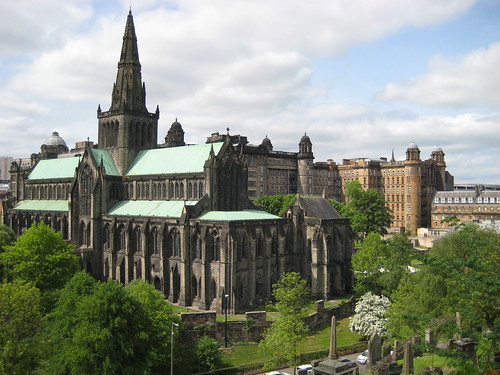
Commanding a central position in the Necropolis and visible from afar is a tall column, a monument to John Knox, who was a leader of the country's Reformation.


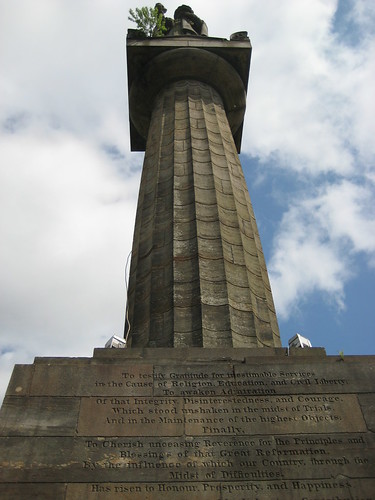
Having meandered and tiptoed along, I descended and started my return, came across unexpectedly a touching work of street art: a Glasgow High Street mural, by Sam Bates, aka Smug. It seems very fitting and is said to relate to St Mungo.
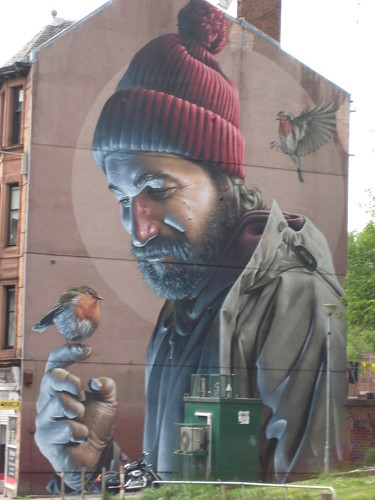
I could have ridden on a bus with the Zonecard, but I felt roaming on foot was generally much more pleasant and kept going through Merchant City and onwards until I was back at the hotel. There was much to observe and entertain, but I felt a sense of loneliness, perhaps an echo of similar feelings I had experienced whilst living here.
The next two days were dedicated to the conference, which was packed with many informative sessions and conversations; I took hardly any photos.
Then I resumed my explorations on foot after the conference had closed, mainly along the River Clyde, taking snaps quite frequently.
The giant Finnieston Crane:
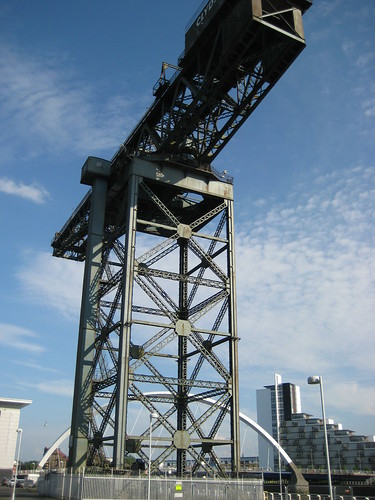
And an unexpected horizon that reflects the evolving nature of belief (religious and secular):
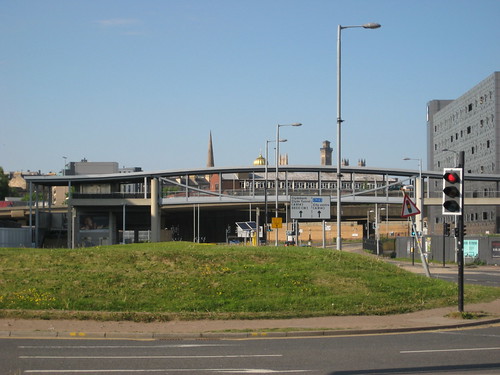
Then across the Clyde Arc:
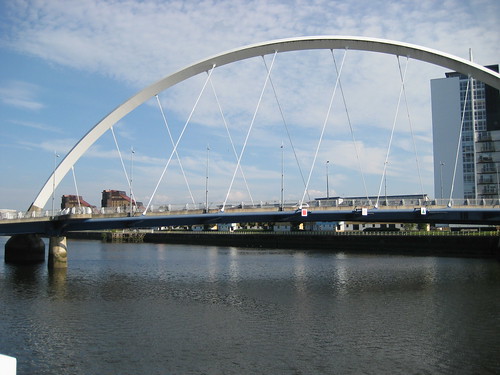
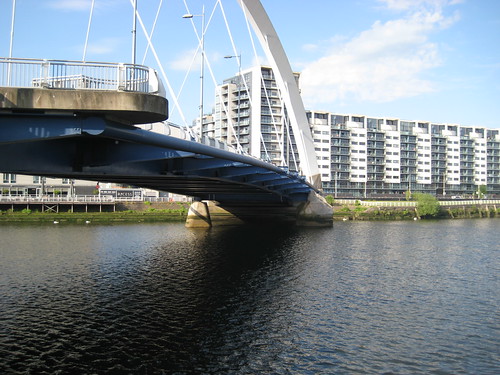
past some rather dilapidated piers

The weather having improved since the beginning of the week offered nice views.
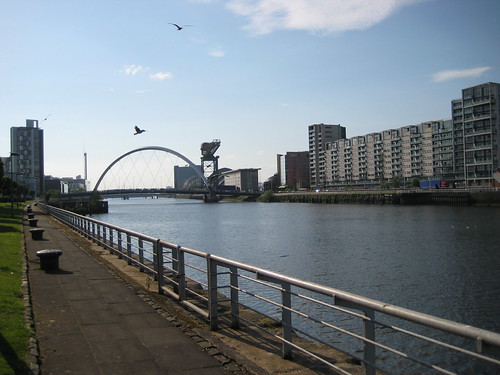
A lot of blocks sprung up in the centre:
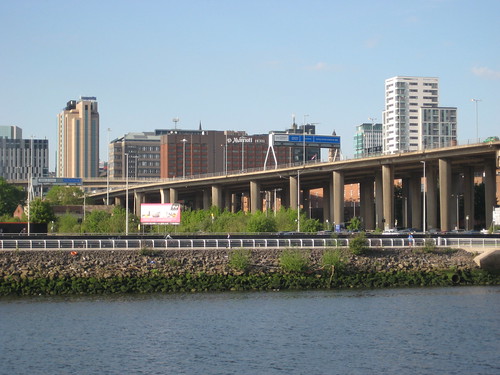
And greater traffic loads to support.
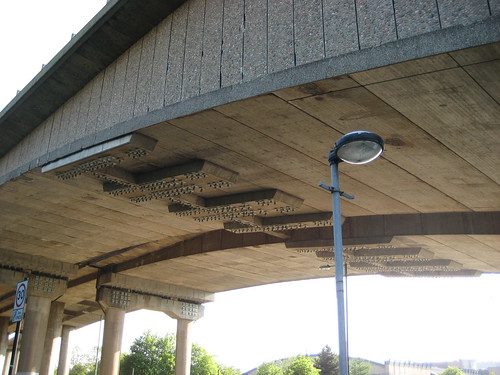
It was a very pleasant strolling along at leisure. A nice way to end the tour of the city.
One place I didn’t get round to revisiting was Hillhead Underground station. This was where I bade farewell to my research supervisor, Prof. Robert (“Bob”) Odoni. Alas he passed away about 10 years later; he was highly regarded by colleagues. (I remember colleagues sharing their mathematical problems with him and a few days later he might go up to them and suggest: “Have you tried this …?”)
Since then Glasgow has undergone far-reaching development; although this dynamism had already started when it was European Cultural Capital in 1990, it feels more international now. However, as with many other cities, I heard about some aspects of modernisation, particularly student apartment blocks, which are changing the nature of some districts and, I suspect, the expectations of its inhabitants.
I took the opportunity to spend a few extra days revisiting the city where I had been a postgrad between 1990 and 1992.

I arrived back in Glasgow on Sunday evening. At Glasgow Central station I bought a weekly Zonecard before proceeding on my way, anticipating quite a lot of travel around the city, reasoning that it should be more convenient than repeatedly buying tickets and I might save some money. Then I towed my luggage along St Vincent Street and Arygll Street to reach the Sandyford Hotel in Sauchiehall Street, where I had booked 5 nights’ accommodation.
A few minutes later under greyish skies, but dry at least, I headed for the waterfront, which was easy to reach from the hotel, using the SECC tunnel walkway

There were many passersby wearing conference lanyards with a great diversity of ethnicity, so I stopped one of them to ask. He explained that they were attending a congress of the World Federation of H[a]emophilia. It seemed a very laudable gathering, but seeing the multitude I soon guessed that was probably why accommodation prices seemed elevated. Soon I emerged by the river and proceeded to cross towards the Prince’s Dock, where once mighty ships would berth, supported by an array of cranes, warehouses and railway yards.

Now this has faded away, with much of the waterway reclaimed (the BBC Scotland occupies some of this area). The area has been redeveloped, but some vestiges of the old practices remain, including the Clyde Puffer.

The next day, fuelled by a substantial cooked breakfast, I set out to explore at length, starting with Kelvingrove Park and then up to Gilmorehill, the location of the imposing Gilbert Scott Buildings, which form the central areas of the University of Glasgow.

A lady doing the polishing at the entrance to the Hunterian Museum explained that it was now quiet as the exams were over and the graduation ceremonies were yet to begin.


Around the corner, in Professors’ Square, was a distinctive sculpture in the form of an urn made of slate. It was produced by Andy Goldsworthy, a donation from a former Principal and his wife, Sir Graeme and Lady Davis:

I then headed downhill to Church Street, but whereas the view used to be of the Western Infirmary, now I saw this:

(sunyata!)
It’s a huge development site for the University (similar to the Radcliffe Observatory Quarter redevelopment in Oxford). Some ragged remnants still remain adjacent to the street:

I returned to the main campus via Byers Road and then continued down University Avenue to University Gardens, where I used to receive instruction at the Maths Department at no. 8 and study at no. 11. Now it looked like this:

(sunyata!!)
At least they hadn’t knocked down the villa, a listed building from the 1880s, where I used to share a sparsely furnished office with other Maths postgrads at George Service House (number 11).
Next door, no. 13, was Hetherington House, home of the Hetherington Research Club, the scene of a student protest in 2011 “against cuts to higher education within Glasgow University and nationwide” (the Hetherington Research Club was closed in 2010). It got widely reported, including BBC coverage and a Wikipedia article.
Seeing that the Maths Department building, a block constructed in the late ‘60s in the Brutalist style, had been demolished I quizzed a security person (I assume) who was standing nearby. He said it was knocked down at the beginning of the year and the completion of the new construction was planned for completiion in 2 years’ time. I expect few would mourn the loss of the old structure.
The flat I shared in Church Street was appropriately described by my flatmate as "a hovel”; cheap, but not so cheerful. So after a few months I moved again and finally found a generally comfortable and affordable place to live, still close to the Maths Department, in Hillhead Street. So on my return I carried on, using a shortcut that I still remembered by Queen Margaret’s Union, to get onto Hillhead Street. And memories started to return…
Miss Macaulay, the landlady, was retired. She had previously run a rest home there, which was apparently particularly popular with Americans. As part of my induction she pointed to the Macaulay clan’s crest with its motto, ‘Dulce periculum est’, which she obligingly translated — “Danger is sweet!”. However, whilst she was proud of her heritage, her tone was not menacing and I was offered two rooms at a generous rate.
I don’t recall having taken any photos, but it’s not so hard to find glimpses of the interior. A few months after I had moved a production company came to do some filming for The Bogieman, a BBC Scotland Comedy Drama from 1992 starring Robbie Coltraine, Midge Ure et al. Here we see the detective approaching the home
Most of the flat was need for the filming, i.e., the entrance hallway, the two front rooms and the kitchen at the back (where they kept all the turkeys). Apparently when it came to finding the right location they reviewed 8 properties and this one won hands down; I don’t think they needed to use so many props for beyond the red door at the entrance was a plentiful supply of tartan, chandeliers, stags heads and especially brass, frequently augmented at weekends by new acquisitions from The Barras.
The BBC wrote to us individually advising what was going to happen. They very kindly allowed me to come and go as I pleased during the filming and I could stay there overnight as my rooms were not used (this also helped them in that I could watch over their equipment). On one occasion as I was making my way through the hallway I bumped into Robbie Coltraine coming out of the front room. Seeing me he immediately remarked in an affected voice, “Don’t go into show business!” and then carried on his way.
Now revisiting, I could barely recognise the flat — gone were the tartan curtains, the front door had been repainted; there was little sign of the distinctive colour from the past. I tried to strike a conversation with a resident outside, but she didn’t want to know (and looked at me with suspicion). So it was soon time to move on, down the hill, past The Mackintosh House

As it was Monday, I knew it would be closed, so next stop was the Kelvingrove Art Gallery and Museum,

It’s a fabulous museum, with a rich mixture of displays, some quite unexpected, particularly the multimedia object cinema, which I found quite immersive. However, I spent most of my time at ‘Mackintosh and the Glasgow Style Gallery’, a permanent display of work by members of the Glasgow School, particularly the Group of Four. Actually, there is also a special exhibition to celebrate 150 years of the birth of the leading light: Charles Rennie Mackintosh: Making the Glasgow Style. My only disappointment was not being able to see Dali’s Christ of St John on the Cross, which is currently on loan.
After coffee in the Centre Hall, I wandered along Argyll Street, past Kelvin Hall, where I remember watching international athletics. Its redevelopment is bringing together disparate Hunterian collections of the University. Its website includes a beta service with integrated online access to search the collections.
I had planned to explore Pollok Country Park on the south side, so it was on to the Underground, where the turnstile rejected my ticket first time I tried it and then again and again. The staff in the ticket office was watching on and gestured to hand over my card. He studied it and with furrowed brow concluded it was meant for buses. Not to worry as he could fix the problem if I waited 10 minutes. So I did and I continued on my way and emerged safely at St Enoch’s. But when I came to the platform where I was to catch the train for Barrhead, the turnstiles there rejected it also. “It’s the magnet”, explained the rail staff cheerily as he let me through. “Och well…”
Disembarking at Pollokshaws station, I headed for Pollok Country Park, passing by Pollokshaws Railway Viaduct, which spans White Cart Water. Built in 1847 and subject to a lot of rail traffic, it must need quite a lot of maintenance.

This scene somehow felt like a metaphor for working in an IT team.
A few yards along Pollok Avenue one finds Shawmuir Lodge, built in 1891, as the stone relief indicates (I guess):

The grounds are part of an estate that belonged for many centuries to the Maxwell family until it was handed over to the Glasgow Corporation with the condition that it remained a public park. The stately home is Pollok House, maintained by the National Trust of Scotland. It’s currently featuring a photography exhibition, Harry Benson: from Glasgow to America, which I found really impressive — he vividly captures many aspects of life with a perfect sense of timing. And lunch was very good too.
The park was delightful with many blooms and I felt no need to investigate the Burrell Collection, though it’s actually ‘temporarily closed’ for refurbishment (estimated until 2020).


I returned to the hotel greatly contented with what I had seen.
The following day I explored towards the east, aiming for St Mungo’s, Glasgow’s cathedral. I took a slight detour to see what was happening with the refurbishment of the Glasgow School of Art following the fire of 2014.

According to the information boards it will reopen in 2019 "as a base for all first year students from across all disciplines: architecture, design, fine art, innovation, simulation and visualisation". Using my map from 1990, I carried on, but lost my way when I hit Buchanan Galleries, a large shopping mall, but eventually I reached my destination and quickly made my way to the shrine of St Mungo. Similar to what happened in Oxford, the shrine gained special attention during the medieval period (in Oxford in the 12th Century, the relics of the patron saint, St Frideswide, were transferred to a special new shrine, and a miracle collection was authored by Prior Philip, detailing miraculous healings, on which I wrote an essay. This was formerly the Roman Catholic mother church of the Archdiocese of Glasgow, but following the Scottish reformation it has been under the Church of Scotland.
I gazed at leisure from the cafe in the nearby Mungo Museum of Religious Art and Life.

I found the museum itself unassuming and quite a lot larger than expected; it seems to unfold, floor by floor. As it doesn’t overwhelm, it lends itself to measured absorption; one can linger on the displays. Its exhibitions are planned in interesting ways, particularly the one space where world religions were introduced in the centre and around it were the stages in life (and death), bringing together different perspectives from the various faiths. There are good education facilities for youngsters and It feels like there’s been good involvement from local communities. And they didn’t shy away from difficult topics such as mission and conversion - it included material on Billy Graham, including a photo of him preaching at Celtic Park in 1991. I went along to listen; he was certainly dedicated to his fath and charismatic, but I didn’t feel a calling to go to the front.
As I left the museum I took a closer look at the Zen garden, which was designed by Yasutaro Tanaka and entitled “Where We Are”. I don’t claim any background, but as I observed the grass growing around the edges, it struck me that it needed maintenance. The few gardens I have seen have all been very precisely arranged with not a stone out of place. Perhaps it needs some specialist maintenance?
Emerging, I continued towards the Necropolis, a bold statement of a Victorian cemetery, as though “from the other side”, about the city’s great and famous in the form of memorial stones. Looking back there were impressive views of the cathedral next to the Royal Infirmary:

Commanding a central position in the Necropolis and visible from afar is a tall column, a monument to John Knox, who was a leader of the country's Reformation.



Having meandered and tiptoed along, I descended and started my return, came across unexpectedly a touching work of street art: a Glasgow High Street mural, by Sam Bates, aka Smug. It seems very fitting and is said to relate to St Mungo.

I could have ridden on a bus with the Zonecard, but I felt roaming on foot was generally much more pleasant and kept going through Merchant City and onwards until I was back at the hotel. There was much to observe and entertain, but I felt a sense of loneliness, perhaps an echo of similar feelings I had experienced whilst living here.
The next two days were dedicated to the conference, which was packed with many informative sessions and conversations; I took hardly any photos.
Then I resumed my explorations on foot after the conference had closed, mainly along the River Clyde, taking snaps quite frequently.
The giant Finnieston Crane:

And an unexpected horizon that reflects the evolving nature of belief (religious and secular):

Then across the Clyde Arc:


past some rather dilapidated piers

The weather having improved since the beginning of the week offered nice views.

A lot of blocks sprung up in the centre:

And greater traffic loads to support.

It was a very pleasant strolling along at leisure. A nice way to end the tour of the city.
One place I didn’t get round to revisiting was Hillhead Underground station. This was where I bade farewell to my research supervisor, Prof. Robert (“Bob”) Odoni. Alas he passed away about 10 years later; he was highly regarded by colleagues. (I remember colleagues sharing their mathematical problems with him and a few days later he might go up to them and suggest: “Have you tried this …?”)
Since then Glasgow has undergone far-reaching development; although this dynamism had already started when it was European Cultural Capital in 1990, it feels more international now. However, as with many other cities, I heard about some aspects of modernisation, particularly student apartment blocks, which are changing the nature of some districts and, I suspect, the expectations of its inhabitants.